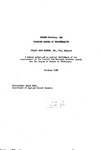MODERN CORNWALL: THE CHANGING NATURE OF PERIPHERALITY
| dc.contributor.author | PAYTON, PHILIP JOHN | |
| dc.contributor.other | Faculty of Arts, Humanities and Business | en_US |
| dc.date.accessioned | 2013-10-08T08:42:54Z | |
| dc.date.available | 2013-10-08T08:42:54Z | |
| dc.date.issued | 1989 | |
| dc.identifier | NOT AVAILABLE | en_US |
| dc.identifier.uri | http://hdl.handle.net/10026.1/2071 | |
| dc.description | Merged with duplicate record 10026.1/778 on 08.03.2017 by CS (TIS) | |
| dc.description.abstract |
The political events of the 1960s and 1970s in "Celtic Britain" led to the demise of the Anglocentric conventional wisdom which had asserted the fundamental homogeneity of the United Kingdom, and ushered in a new orthodoxy which stressed diversity and the territorial dimension of the state. Ihese events were mirrored to an extent in Cornwall, with competing explanations seeking to interpret "peripheral protest", but with a more comprehensive model emerging to emphasise the complexity of the relationship between "centre" and "periphery" in modern western European states, pointing in particular to the existence of historical phases of peripherality. In an initial phase of "Older Peripheralism", Cornwall was isolated territorially and culturally from the core of the expanding English state, conquered and annexed but with an array of constitutionally "accommodating" devices and a multi-faceted Celtic identity. However, political and economic change eroded this isolation, creating a new era of "second Peripheralism". This phase was marked by a rapid industrialisation which brought Cornwall into the forefront of technological innovation but which was over-specialised and incomplete, leading initially to a new, assertive sense of identity based upon technological prowess but precipitating in the longer term industrial collapse and a consequent Cornish social, economic and political paralysis. This paralysis endured from the end of the nineteenth century until after the Second World War, an experience which was highly distinctive when compared to that of England. However, this paralysis was at length disturbed, with post-war Regional Development policies facilitating the construction of a "branch factory" economy in Cornwall and encouraging a process of "counterurbanisation”. Paradoxically, this socio-economic movement led not to the erosion of Cornwall's peripheral status but was in fact evidence of a "Third Peripheralism", with the Cornish economy acquiring features which continued to contrast with those of England's core, and with an increasingly politicised "Cornish Revival" injecting an important strand of anti-metropolitanism into Cornish political behaviour, with its critiques of regional policy and demands for renewed constitutional "accommodation". | en_US |
| dc.language.iso | en | en_US |
| dc.publisher | University of Plymouth | en_US |
| dc.title | MODERN CORNWALL: THE CHANGING NATURE OF PERIPHERALITY | en_US |
| dc.type | Thesis | |
| plymouth.version | Full version | en_US |
| dc.identifier.doi | http://dx.doi.org/10.24382/4644 | |
| dc.identifier.doi | http://dx.doi.org/10.24382/4644 |
Files in this item
This item appears in the following Collection(s)
-
01 Research Theses Main Collection
Research Theses Main


